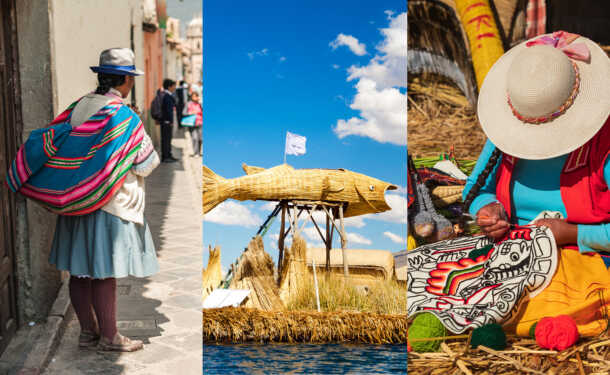Tropical beaches, Old World architecture and exotic cuisine — some things can only be found across borders or in distant lands.
That’s why international destinations are at the top of travel bucket lists everywhere. Everyone wants to see the blue waters of the Caribbean, the nighttime sparkle of the Eiffel Tower and the white domes of the Taj Mahal. But getting there is frequently expensive and often requires extensive planning. That’s where group travel comes in. Exploring the world with a group is safer, less expensive and often more fulfilling.
While many travel planners rely on experienced international tour operators to take their groups abroad, we’ve compiled some good advice to help you make that trip happen — whether you plan it yourself or use another tour operator.
What’s Different
Travel There First
For some domestic destinations, you can get away with taking travelers to places you’ve never visited yourself. It’s easier when you speak the language, have communicated with the local DMO, and have hand-selected restaurants and attractions based on research. In international destinations, you might not be so lucky.
That’s why it’s important to visit whichever country you plan on taking your group to beforehand. You can meet up with the local guide you plan to hire, meet vendors that will be accommodating your group, and check out the attractions and lodging firsthand. This will help you foresee and solve any problems before you encounter them.
Traveler Documents
The document every international traveler knows about is a passport. These take time to get, and even expedited passports can still take a few weeks to arrive. That’s why it’s crucial to verify each of your travelers has a passport that’s going to be valid for at least six more months; if it is too close to expiring, some countries won’t accept it. But passports aren’t the only documents travelers need to worry about.
While most European and South American countries that U.S. residents visit don’t require a visa for stays of 90 days or less, some Asian and Middle Eastern countries do. Check the State Department’s website for entry requirements. In some destinations, travelers will also have to think about health mandates, like vaccinations. Make sure each of your travelers is aware that these are not optional and inform them in advance of the timeline they’ll need to follow and what documentation they’ll need from their doctor’s office.

In preparation, always visit the country or countries you plan on taking your group to.
Packing
First-time international travelers might feel a little overwhelmed when they’re packing for a trip abroad, which is why your guidance will make all the difference. There are a few key items they’ll need to prepare. The first is a power adapter with the appropriate prongs for outlets in other countries. A portable power bank to recharge devices might also be helpful for the long journey.
Currency is another thing they’ll need to prepare to bring in advance. It’s much easier for travelers to exchange currency at their local bank than wait in long lines at the airport. Tell them to make this exchange a few weeks before the trip so they don’t risk long wait times.
On the packing list, you should also recommend comfy airport attire and a neck pillow to make long flights a little more restful; comfortable walking shoes that have already been broken in; zip-lock bags for sealing food and beverage souvenirs; weather-appropriate attire for the countries you plan to visit (take into account their altitudes as well); and a reusable water bottle.
Contingency Plans
We all know travel insurance is a must, but it’s particularly important when traveling internationally. Longer flights and more layovers create greater chances for missed or cancelled flights; plans in the Caribbean are prone to being disrupted by major weather events like hurricanes; and political uncertainty like strikes or protests can quickly change how safe it is to visit. To stay on top of this information, keep an eye on the State Department’s website and take note of any travel advisories for your group’s destination. Make sure to tell your travelers to book insurance that covers trip cancellations, trip interruptions, trip delays, baggage loss or delay, and emergency medical. They’ll also need to cover medical evacuations in the event of an injury that can’t be treated abroad. Encourage travelers to double-check that their insurance policy covers the country and the trip length and ensure that expenses like travel, lodging and emergency cash are covered.
You should also have your own backup lodging, vendors and guides in case any aspect of your trip goes awry. Make sure you’re in touch with the country’s tourism agencies, and if you’re going to any place with a travel advisory, know where the American embassies are located. It’s highly unlikely your trip will go that wrong, but being prepared for an emergency is a necessary part of trip planning.
Communication
Most phone plans won’t automatically work outside of the U.S., so your travelers will need to purchase some kind of plan from their mobile carriers that covers the length of the trip, including travel days. It’s also a good idea to use some kind of communication app for the group chat, such as WhatsApp or GroupMe, so that local guides or vendors can be added and kept informed of travel changes, delays or anything else that might affect them. Start these group chats before you leave to make sure everyone is acquainted when the trip begins.

Employing a local guide or receptive operator can take your trip to the next level.
What’s the Same
Group Meals
No matter where you are in the world, feeding your group requires plenty of research. You have to find restaurants large enough and well-staffed enough to accommodate large groups. You have to find something with enough options that everyone will be satisfied. And you have to watch out for dietary restrictions and preferences among your travelers. That’s why it’s always good to contact local tourism resources, whether you’re traveling domestically or internationally — they’ll always have a good mix of recommendations for you, no matter your tastes. Local guides can assist with any language barriers once you arrive at the restaurant.
Hotels
Most hotels are going to offer your group similar experiences, provided you’re staying at ones of the same caliber; don’t try to compare a hostel to a five-star resort. Groups will largely feel at home in a hotel the same way they would in the U.S. Many of the amenities and customs will be similar because hotels around the world are used to hosting international travelers.
Mix of Free Time and Structured Activities
No matter where they are in the world, travelers will appreciate a mix of structured activities and downtime during their itineraries. You can keep them together to enjoy the destination highlights, such as guided tours of medieval castles, wine tastings at local vineyards or hikes to breathtaking natural wonders. Group experiences frequently offer add-ons or extra experiences not available to the public, so these structured activities give your travelers a little extra something special.
However, giving them ample time to shop, dine and explore on their own or in small groups is a great way to let them independently explore their own interests. Some travelers may simply be interested in sneaking in an afternoon nap so they’ll be refreshed again for the group dinner. Either way, it slows down the often breakneck pace of a group trip and gives travelers a feeling of autonomy and discovery as they experience the destination in their own way.
It’s Better with a Local Guide
Even if you’re just taking your group one state over, employing a local guide or receptive tour operator can take your trip to the next level. That’s as true with international travel as it is with domestic travel. Local guides are experts on their destinations. They’ve seen common travel mistakes in the area, they know when an attraction is a rip-off, and they can help you find a destination’s hidden gems. On international trips, a guide who speaks the local language can cut down on any miscommunications or cultural clashes. They can also advise you on your group’s itinerary, translate important information and help navigate any contingencies once you arrive.
High and Low Tourism Seasons
In the States or abroad, every destination has a shoulder season. Some locations that suffer from overtourism will always have a crowd, but it will inevitably ebb and flow with weather, seasons and important events. Avoid going to destinations during their peak if you want to avoid high costs and overwhelming crowds. If you decide to visit one of the tourist hotspots of the world, make sure you go during the shoulder season to avoid contributing to overtourism and to keep your group happy.

Peru has multiple UNESCO World Heritage Sites spread throughout the country, including Lake Titicaca to Machu Picchu, Lima and Cusco.
International Travel Ideas
Single Destination
Many travelers, especially those going abroad for the first time, might find the idea of a multicountry itinerary intimidating. One way to flex their travel muscles without getting overwhelmed is to head to a singular city or region with lots to do; that way, they don’t have to worry about entry requirements for multiple countries, multiple currencies or multiple languages. In addition to exploring the destination in-depth, travelers can take day trips to nearby landmarks, cities or attractions to explore further. Make sure the destination has plenty of sights to fill the entire itinerary and some nearby options for day trips to add variety.
Trip Ideas:
-
Florence, Italy
-
Highlights: See famous art, including Michelangelo’s “David,” at some of the world’s most famous museums, enjoy walkable city streets and enjoy the Tuscan region with day trips to wine country and ancient cities.
-
Day trips: Pisa, Siena, Lucca and Chianti
-
-
Reykjavík, Iceland
-
Highlights: Enjoy geothermal spas, Nordic architecture, the Northern Lights or the midnight sun, with day trips to breathtaking natural wonders.
-
Day trips: The South Coast, the Golden Circle and the Snaefellsnes Peninsula
-
-
London, England
-
Highlights: Take in plenty of history with stops at the British Museum, Shakespeare’s Globe and the Natural History Museum, or catch a play in the West End.
-
Day trips: Bath, Stonehenge, Oxford and Brighton
-
-
Tokyo, Japan
-
Highlights: Explore the bustling city of Tokyo, including its historic temples and modern skyscrapers, with day trips to see some of the islands’ beautiful natural features and cultural gems.
-
Day trips: Mount Fuji, Kamakura, Hakone and Yokohama
-

Florence Cathedral in Florence, Italy; Northern lights in Iceland; and Mount Fuji near Tokyo are international favorites for groups.
Multi-Destination
For more seasoned travel groups or those looking to pack the most they can into their international trip, a multi-destination itinerary may be the perfect fit. Whether it’s an exploration of Italy from Venice to Rome or an adventure through multiple nearby countries, this can be a satisfying way to cram culture and excitement into a trip. Keep in mind the more countries you’ll be visiting — each with different languages and currency — the more preparation you and your travelers will need. You’ll need to do plenty of research and have a local guide in each destination. Don’t make the mistake of assuming one destination will automatically be like another; going from Scotland to Ireland might not require the use of more than one language, but your travelers will have to pack both British pounds and euros.

Visit Scotland, Ireland, and London for a fabulous, multi-destination trip.
Trip Ideas:
-
United Kingdom and Ireland
-
London — Scotland— Ireland
-
-
Central Europe Highlights
-
Berlin — Prague — Vienna — Budapest
-
-
Exploring Peru
-
Lima — Cusco — Machu Picchu
-
-
Southeast Asian Adventure
-
Vietnam — Cambodia — Thailand
-
Cruises
Cruises of all kinds make international trips a breeze; they cut down on hotel-hopping for groups and let travelers enjoy multiple destinations on the same trip. Meanwhile, planners can relax and enjoy knowing that the onboard restaurants, amenities and staff can take care of almost anything travelers need. Additionally, cruises usually offer guided excursions for groups in every port.
If you’re planning a group trip abroad, booking a cruise can be an easy way to outsource some of the trickiest parts. Large enough groups can charter their own vessel and may even find that it’s a cheaper option than booking hotels on land.
Whether it’s on a massive ocean liner from brands like Royal Caribbean or Carnival or a quaint river cruise along the world’s most popular waterways by brands like CroisiEurope or AmaWaterways, cruises open a new world of possibilities, and that makes it easy for everyone to get on board.

Cruises offer a great way to take in a region; try an ocean liner to enjoy the Caribbean, experience the vibrant
Mediterranean aboard a cruise ship, or see Europe as you wind you way along aboard a Danube river cruise.
Trip Ideas:
-
European River Cruise
-
Travelers can explore Europe’s major waterways, such as the Danube, Rhine or Rhone rivers, and see some of its most exciting cultural landmarks at each port. Many river cruises even feature themes, such as European Christmas markets or French wine.
-
-
Caribbean Ocean Liner Cruise
-
Many cruises depart from ports like Fort Lauderdale or Miami and take passengers to sunny, tropical destinations like Mexico or Turks and Caicos. Onshore excursions can include tourist resorts for snorkeling and beach days or more adventurous stops, like Mayan ruins.
-
-
Mediterranean Cruise
Cruising the Mediterranean Sea gives groups the chance to see many of the world’s cultural hubs. Popular ports include Greece, Croatia and Istanbul in the eastern portion or the coasts of Spain, France and Italy to the west.









